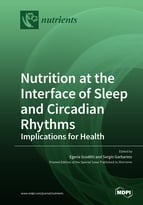Nutrition at the Interface of Sleep and Circadian Rhythms: Implications for Health
A special issue of Nutrients (ISSN 2072-6643). This special issue belongs to the section "Nutritional Epidemiology".
Deadline for manuscript submissions: closed (20 June 2022) | Viewed by 79353
Special Issue Editors
Interests: nutrition; signaling pathways; chronic disease; genomics; cardiometabolic diseases; inflammation; oxidative stress; miRNAs
Special Issues, Collections and Topics in MDPI journals
Interests: neurophysiology of sleep; stress-sleep relationship; psychopathology; mental health; suicide
Special Issues, Collections and Topics in MDPI journals
Special Issue Information
Dear Colleagues,
An integral part of homeostasis includes daily rhythms in physiology, behavior, and metabolism. The circadian timing system enables organisms to adapt their biological functions, such as eating/fasting, sleep/alertness, as well as immune function and endocrine signaling, to the cyclic nature of the environment on Earth, mostly the daylight cycle. Intimately intertwined with the circadian clock, sleep is a physiological function fundamental for survival that, far from being a passive condition, plays a crucial role in physical, mental, and emotional health. Alterations of sleep quality and quantity, especially sleep deprivation, caused by modern society’s lifestyle and behavior as well as by sleep disorders have been associated with deregulation of the neuro-immune-endocrine functions and with an increased risk for diseases including cardiovascular, metabolic (obesity, metabolic syndrome, type 2 diabetes), infectious, cognitive, neurodegenerative, and cancerous diseases. Similarly, chronic misalignment of an organism’s endogenous rhythms can lead to metabolic dysfunction and increases the risk for multiple diseases that involve circadian components including obesity, type 2 diabetes, hypertension, atherosclerosis, heart diseases, neurodegeneration, and cancer in their pathology.
Research is starting to demonstrate the complex interrelationship between nutrition, sleep, and the circadian system, where nutritional pattern, nutrient composition and metabolism, and food timing affect sleep pattern and/or circadian clock components and vice versa. For example, some foods and nutrients may impact the availability of substances that influence sleep, promoting or altering it. On the other hand, inadequate sleep and especially short sleep duration is associated with unhealthy nutrients intake and altered metabolism. Many metabolic rhythms and amplitude of clock gene expression rhythms in clocks outside of the master pacemaker exhibit progressive dampening with age, contributing to the increased risk of metabolic diseases in older adults. A reciprocal influence between nutrition and the circadian system has also been invoked: nutrients can act as drivers of circadian rhythms, and have the ability to target the circadian clock components and to modulate the circadian regulation and, eventually, misalignment of biological functions in specific tissues and across tissues.
Many gaps in knowledge still exist in the interplay of nutrition with sleep and the circadian system as they modulate human health, and more research is needed to expand the field and further understand the impact of nutrients and nutrition patterns on sleep and circadian clock system and vice versa, the underlying molecular pathways, the differential effect in physiologic and pathophysiologic conditions (based on chronotype and across our lifespan), as well as the influence of genetic or epigenetic variations. With this step forward in integrative physiology, novel opportunities are disclosed for developing tailored nutritional recommendations with beneficial effects on sleep and circadian rhythmicity so as to increase healthy lifespan and prevent or treat chronic diseases.
Dr. Egeria Scoditti
Dr. Sergio Garbarino
Guest Editors
Manuscript Submission Information
Manuscripts should be submitted online at www.mdpi.com by registering and logging in to this website. Once you are registered, click here to go to the submission form. Manuscripts can be submitted until the deadline. All submissions that pass pre-check are peer-reviewed. Accepted papers will be published continuously in the journal (as soon as accepted) and will be listed together on the special issue website. Research articles, review articles as well as short communications are invited. For planned papers, a title and short abstract (about 100 words) can be sent to the Editorial Office for announcement on this website.
Submitted manuscripts should not have been published previously, nor be under consideration for publication elsewhere (except conference proceedings papers). All manuscripts are thoroughly refereed through a single-blind peer-review process. A guide for authors and other relevant information for submission of manuscripts is available on the Instructions for Authors page. Nutrients is an international peer-reviewed open access semimonthly journal published by MDPI.
Please visit the Instructions for Authors page before submitting a manuscript. The Article Processing Charge (APC) for publication in this open access journal is 2900 CHF (Swiss Francs). Submitted papers should be well formatted and use good English. Authors may use MDPI's English editing service prior to publication or during author revisions.








